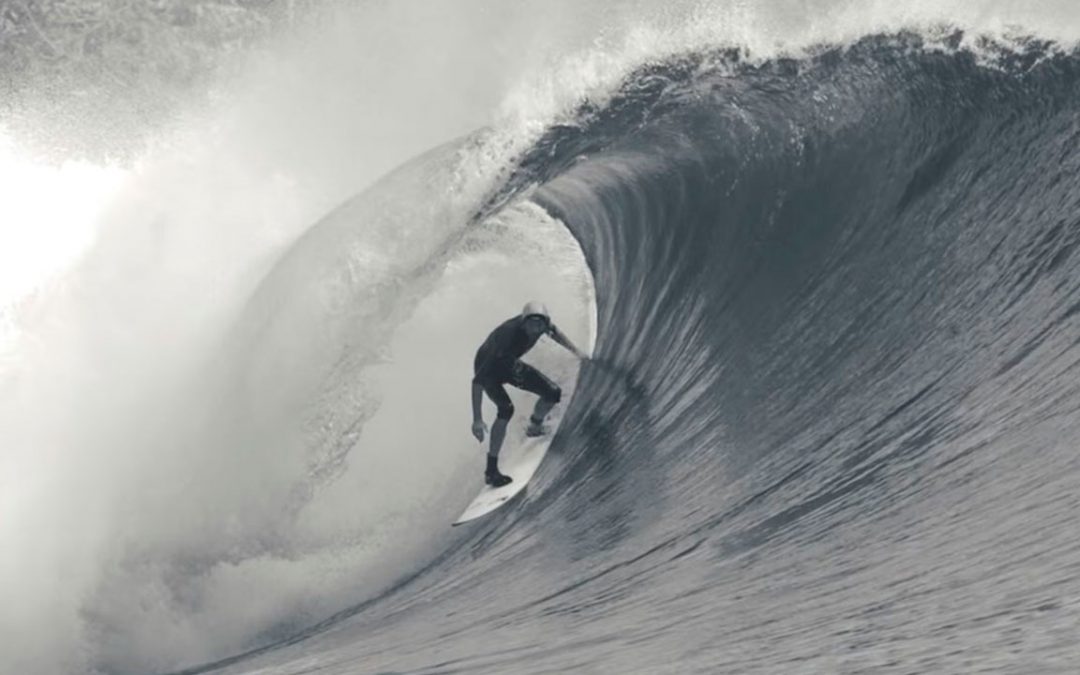
The O’Riginals – Travis Potter
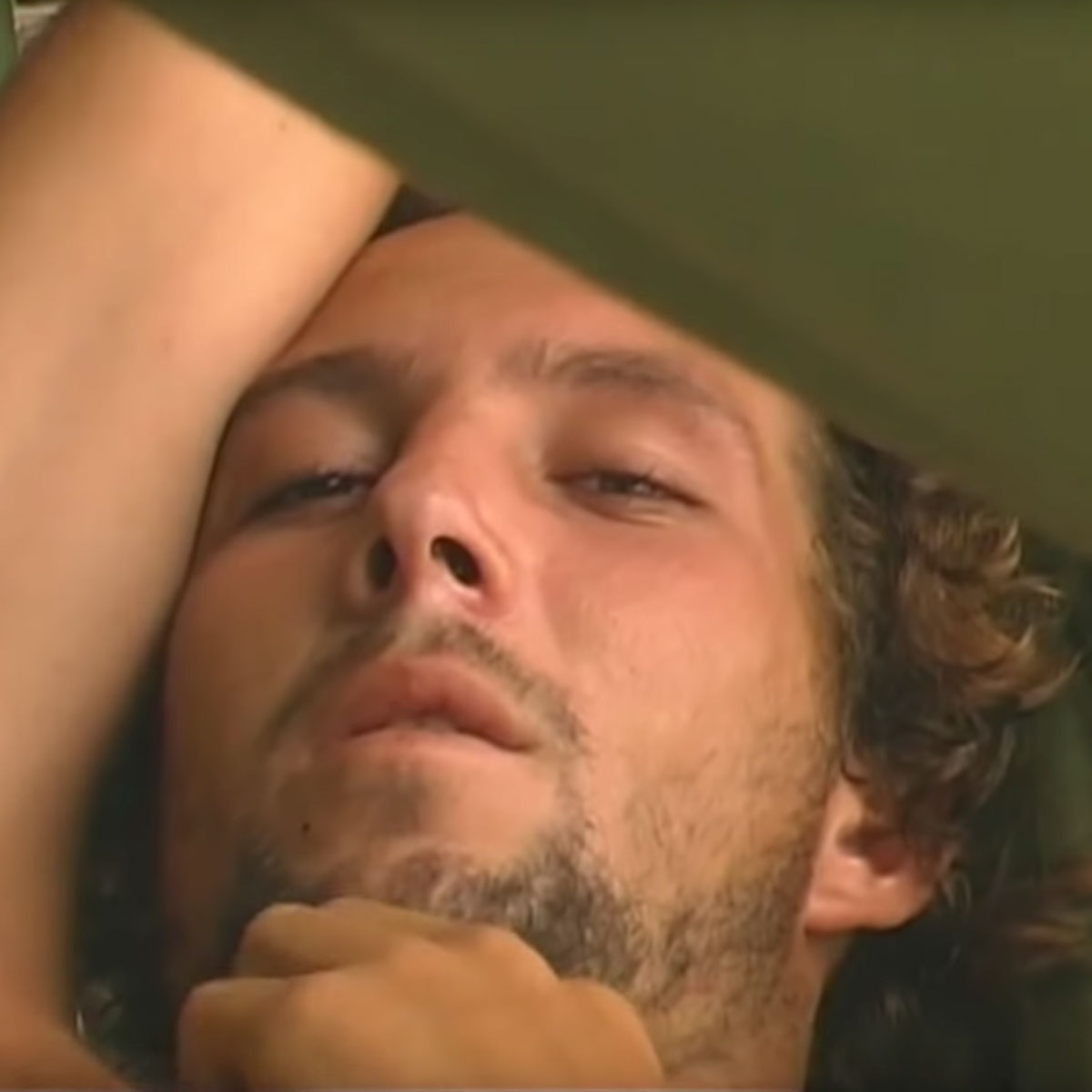
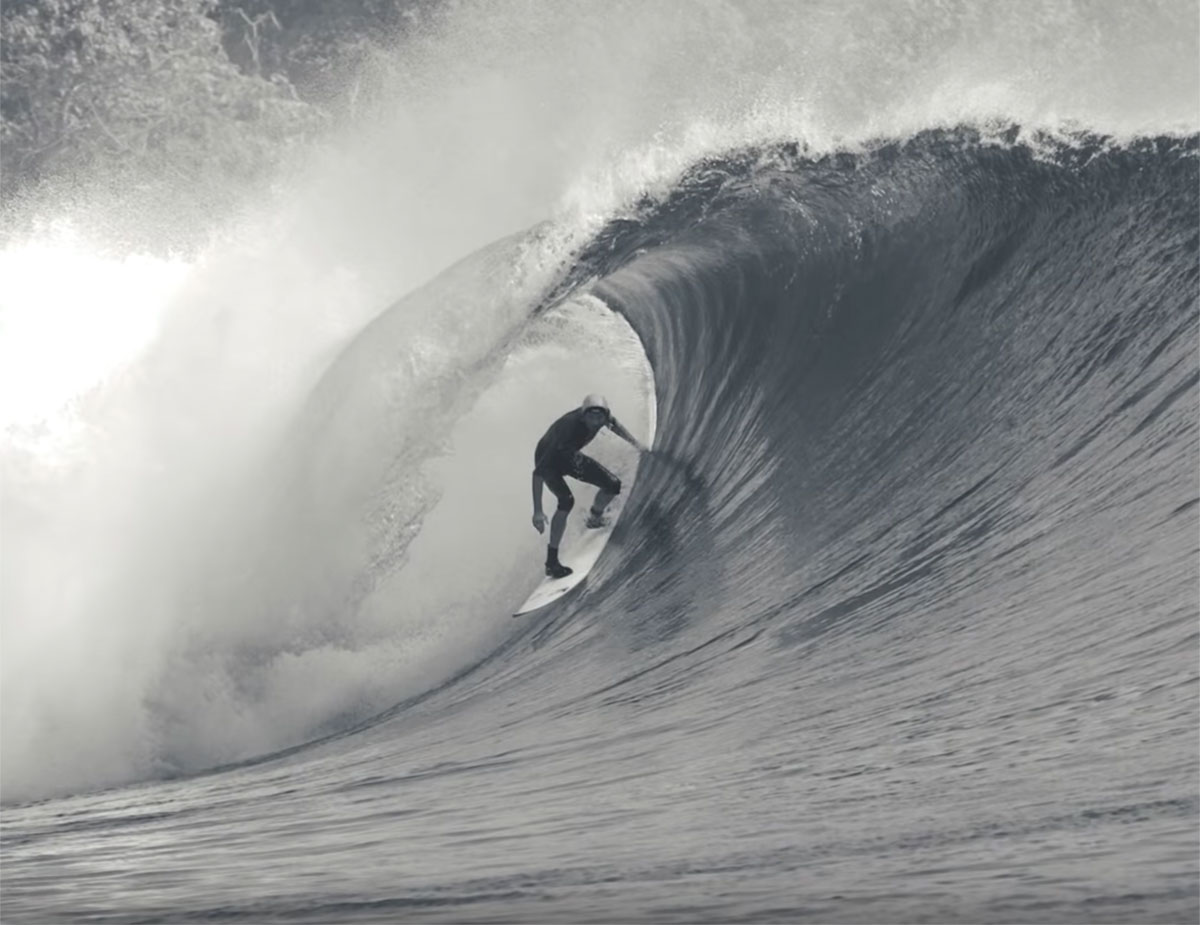
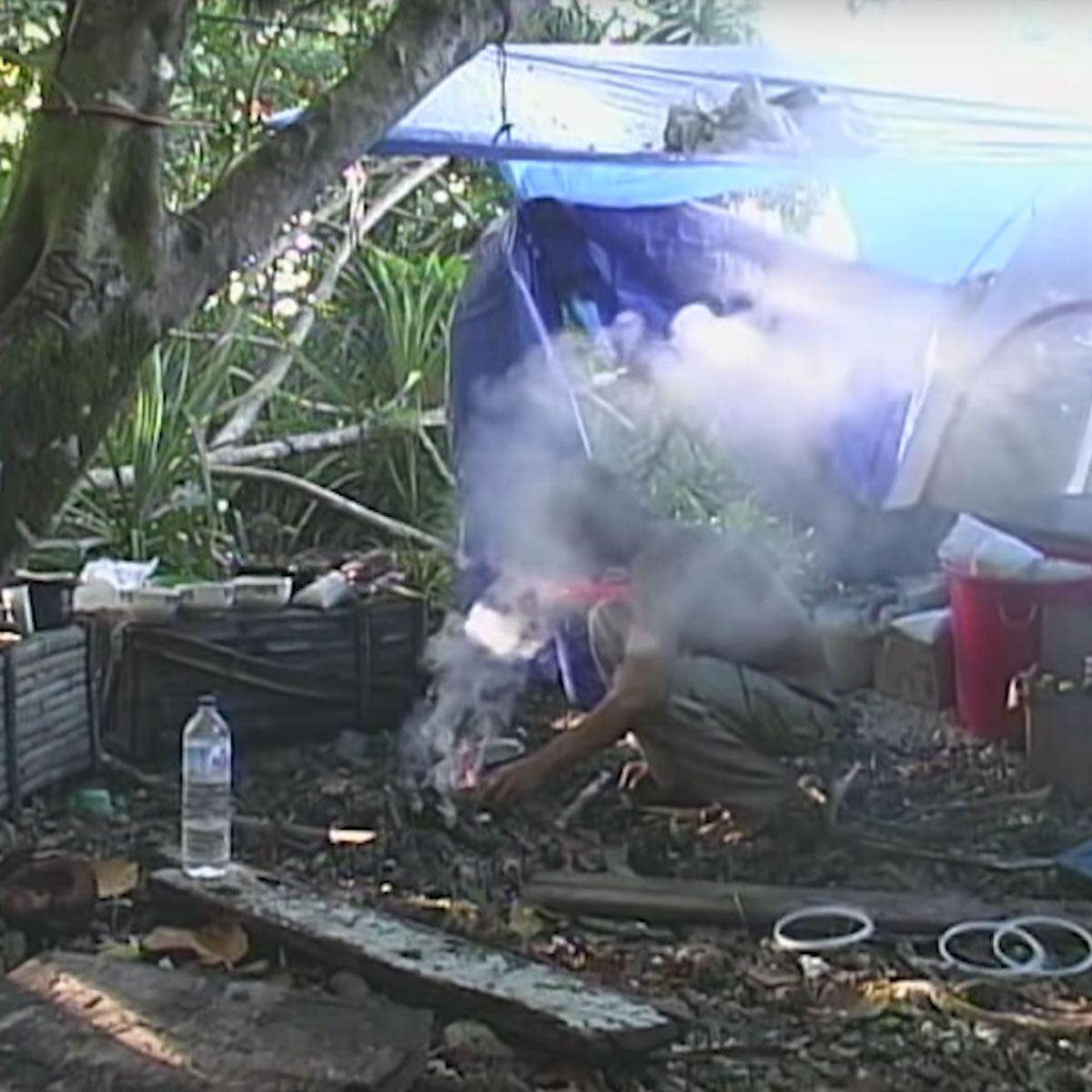




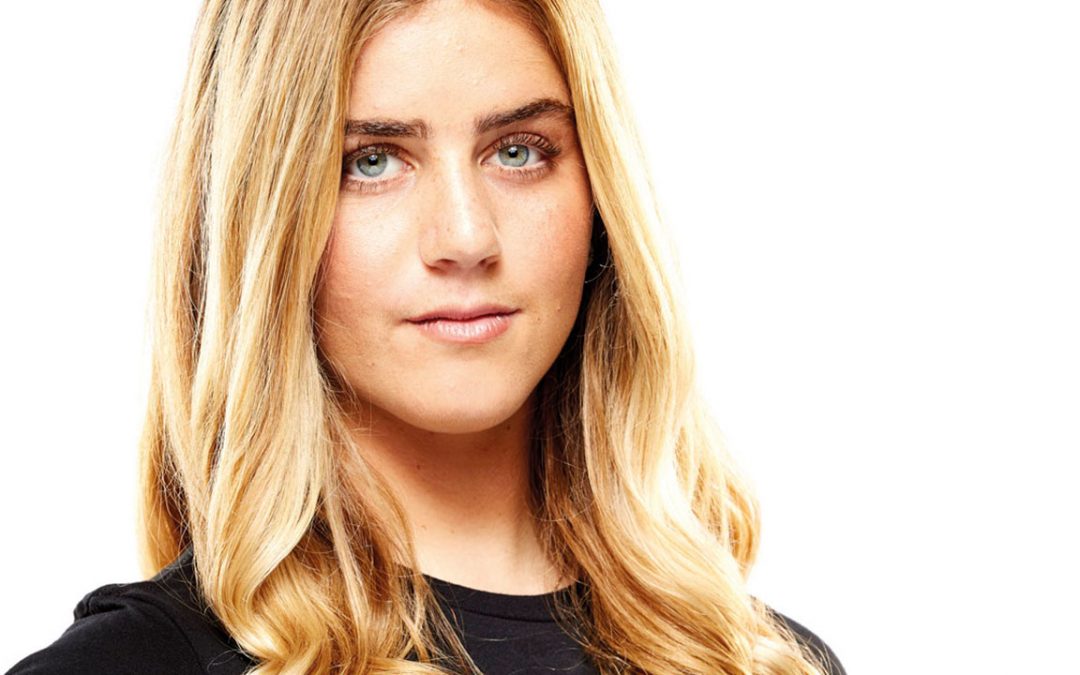
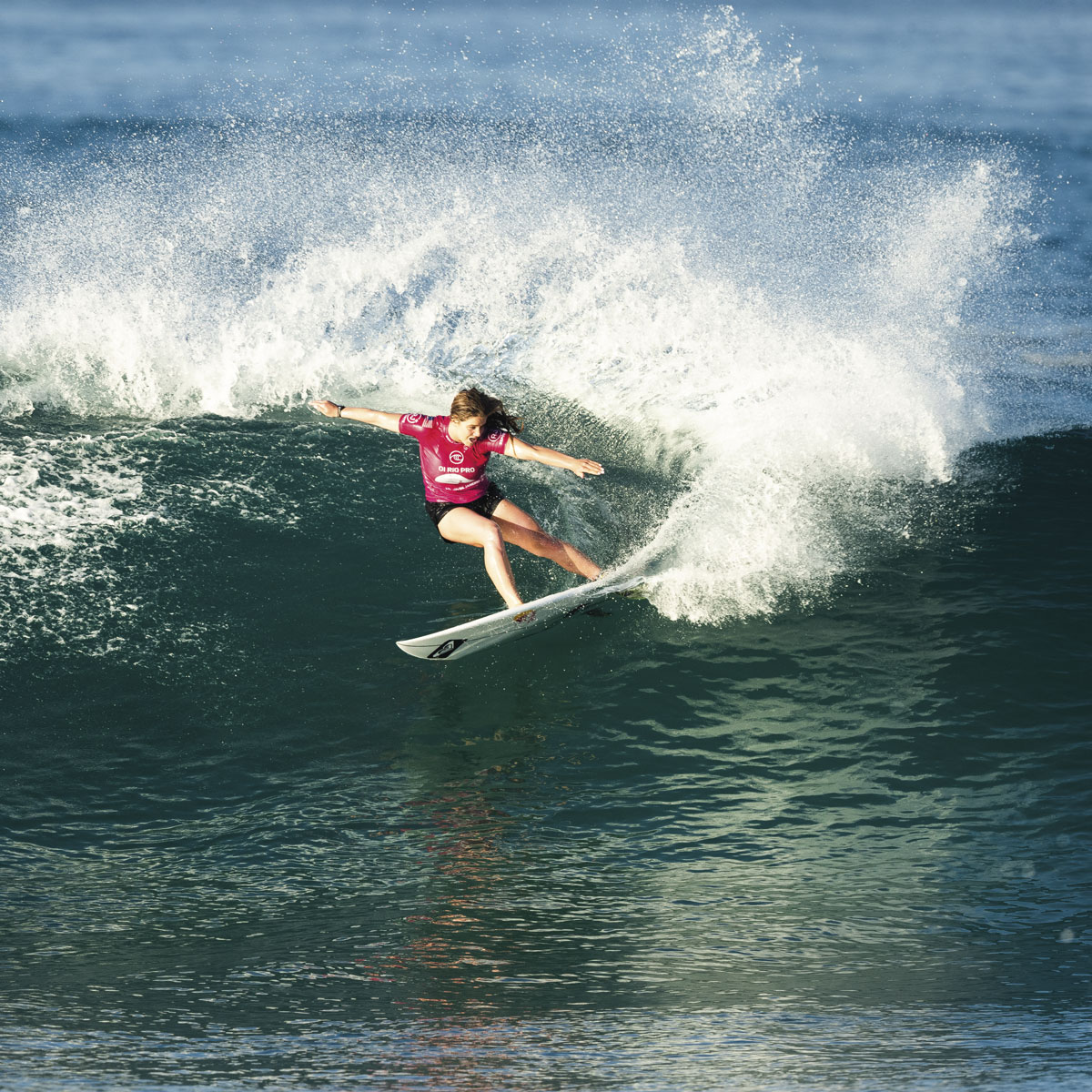
Words by Craig Jarvis Photos WSL
Much like the constant Ethan Ewing comparisons to Andy Irons, the comparison of young Women’s Championship Tour Caroline Marks to 1999 world champion Mark Occhilupo is constant. The 2018 Rookie Of The Year has a compelling and robust style, but it has enough of her characteristics and quirks to make it unique. It was this style that saw her take out the first event of 2019, the Boost Mobile Pro, at Duranbah Beach in Australia earlier this year.
The American surfer is getting her fair share of attention, partially because the CT win came at 17 years of age, the youngest surfer to win a women’s CT event. Her finals performance was brilliant, despite the small and onshore conditions. She displayed a Big Match Temperament that saw her surf to her full potential without nerves, and without making any mistakes.
Some of the comparisons to Occy are correct, however. She is a goofy-footer, with a low stance, compressing all her power into her lower body. She also has one of the most powerful backhand hacks in the business, throwing spray into the sky whenever she goes near the lip. The comparisons continue. Much like Occy, she rarely falls off, and even her most radical turns are usually successful as a result of her low centre of gravity. We chatted about life and the universe.
At the previously – mentioned young age of 17, she still has been surfing since forever. “My first surf memory was surfing with my dad on top of his longboard,” remembered Caroline.” I think I was about three years old.”
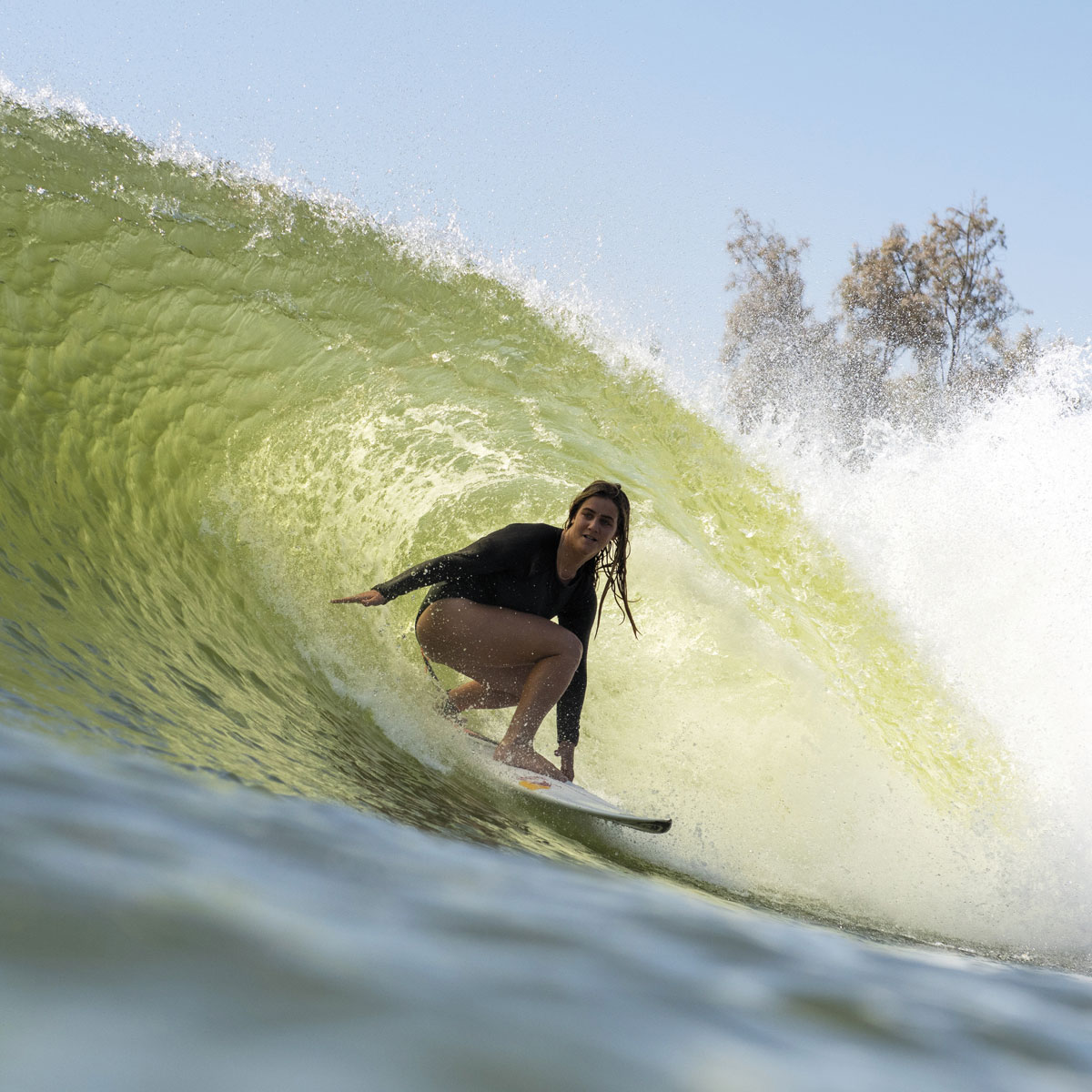
Talking about memories, Caroline is banking her fair share of good ones these days. That sort of stuff happens when you start winning Championship Tour events.
“The best surfing memory I have ever had would probably be winning the first event of the season and getting the yellow jersey,’ reckoned Caroline. “My whole family was there that whole week supporting me on. It truly was a dream come true.”
A dream come true, indeed, but not without a whole lot of hard work. As any champion sportsperson would know, with hard work, come the results, and the win in Australia wasn’t that big a surprise for her.
“No, I was actually not that surprised,” she said on her momentous result. “I am obviously super stoked with my results and how I’ve been able to compete on such a big stage. I’m just having so much fun on tour. It’s absolutely everything I wanted to be doing right now.”
Caroline knows what she has, and is indeed grateful for the life that her talents and hard work have opened up for her. “The best thing about this competitive surfing life that I am living right now is probably just getting to surf the best waves in the world,” said Caroline. “I also get to experience all the awesome cultures and making memories with my family and best friends.”
Much like Jordy Smith, she is also a competitive surfer more than anything else, and her entire surfing focus is on winning heats. This approach is the one that will see her winning more and more heats as she gets more experience on tour and settles into her rhythm. A world title is very likely, and multiple world titles just as likely.
“Sometimes it does get hard out there,” added Caroline. Being away from family is sometimes challenging, and jet lag can be difficult at times.”
She does have her sights set high, however, and so they should be with someone blessed with her talent and skillset. “Five years from now? Hopefully, I’ll be winning lots of events, having a blast on tour and living out my dream.”
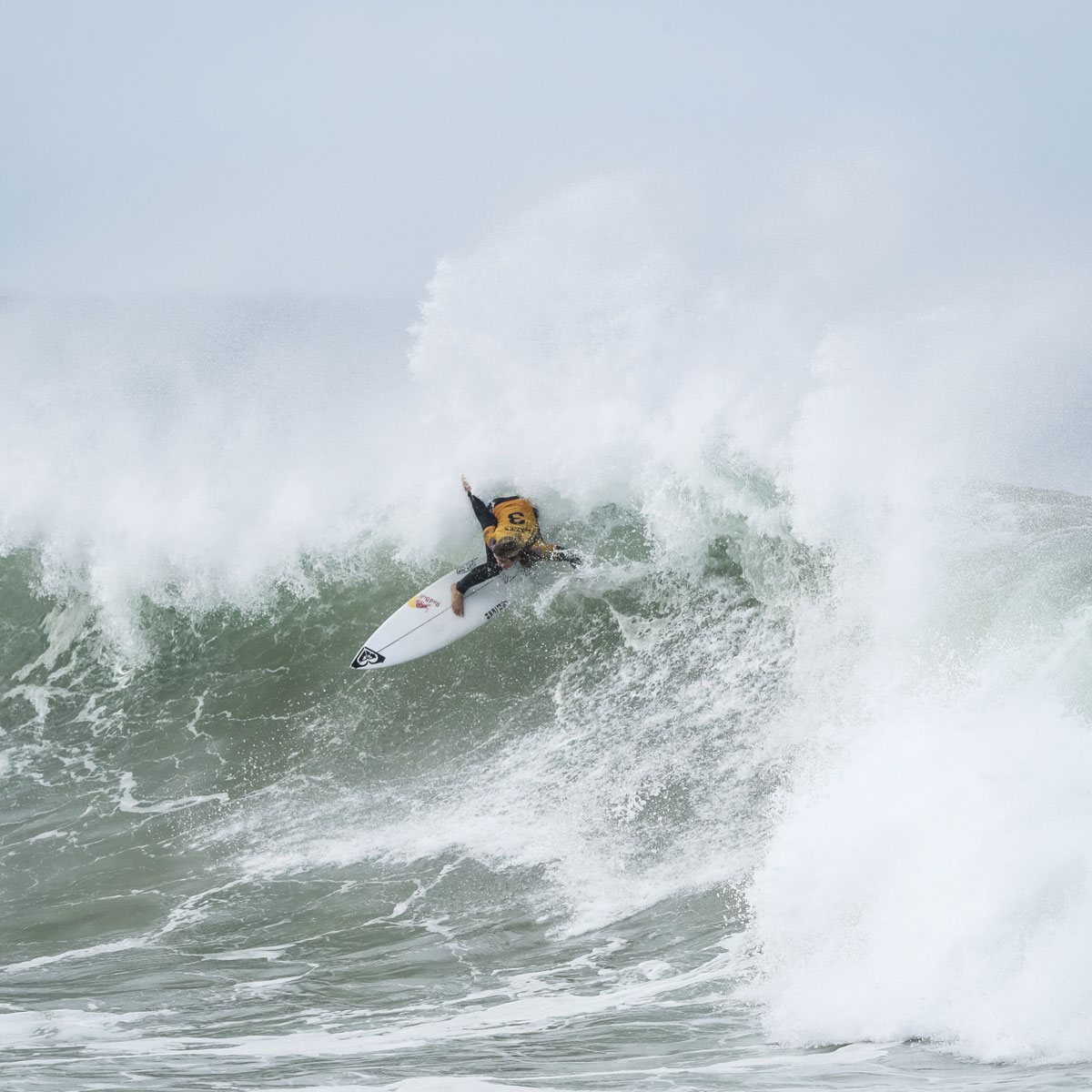
So we got into the more difficult questions, including the ‘dinner with famous surfers’ scenario. Caroline responded with aplomb. “Firstly, three surfers isn’t enough,” she said to my first line of questioning. “I’m going to choose five, and they would be John John, Mick Fanning, Mark Occhilupo, Kelly Slater and Gabriel Medina.”
Excellent choice, but what would you guys yak on about?
“I would go straight in and ask them what is the best advice they have ever been given in their career, as well as ask them about the best wave they have ever had in their life,” said Caroline.” Can you imagine the answers that could come out?”
Caroline loves life on tour, and all the events, but her favourites are all the events in Australia, as well as the JBay Open. When it comes to free surfing, she chooses a famous left that was once upon a time a jewel in the Championship Tour crown.
“My favourite wave to surf in the whole world is most definitely Cloudbreak,” said Caroline. “I went on a surf trip there when I was 14 with all the girls the week before the Fiji event started, and it was one of the best trips of my life. It has all the platforms to get barrelled, do airs, and huge carves. Doesn’t get much better than that!”
Apart from the jet-lag and being away from family, there are other aspects to be a travelling professional surfer that not all of us know about or even think about. “My worst travel experience so far must be what I went through in Brazil,” remembered Caroline of the Oi Rio Pro event earlier this year. “I didn’t get my boards until the night before I surfed my heat. I felt like a caged lion. So excited to surf once I got my boards.”
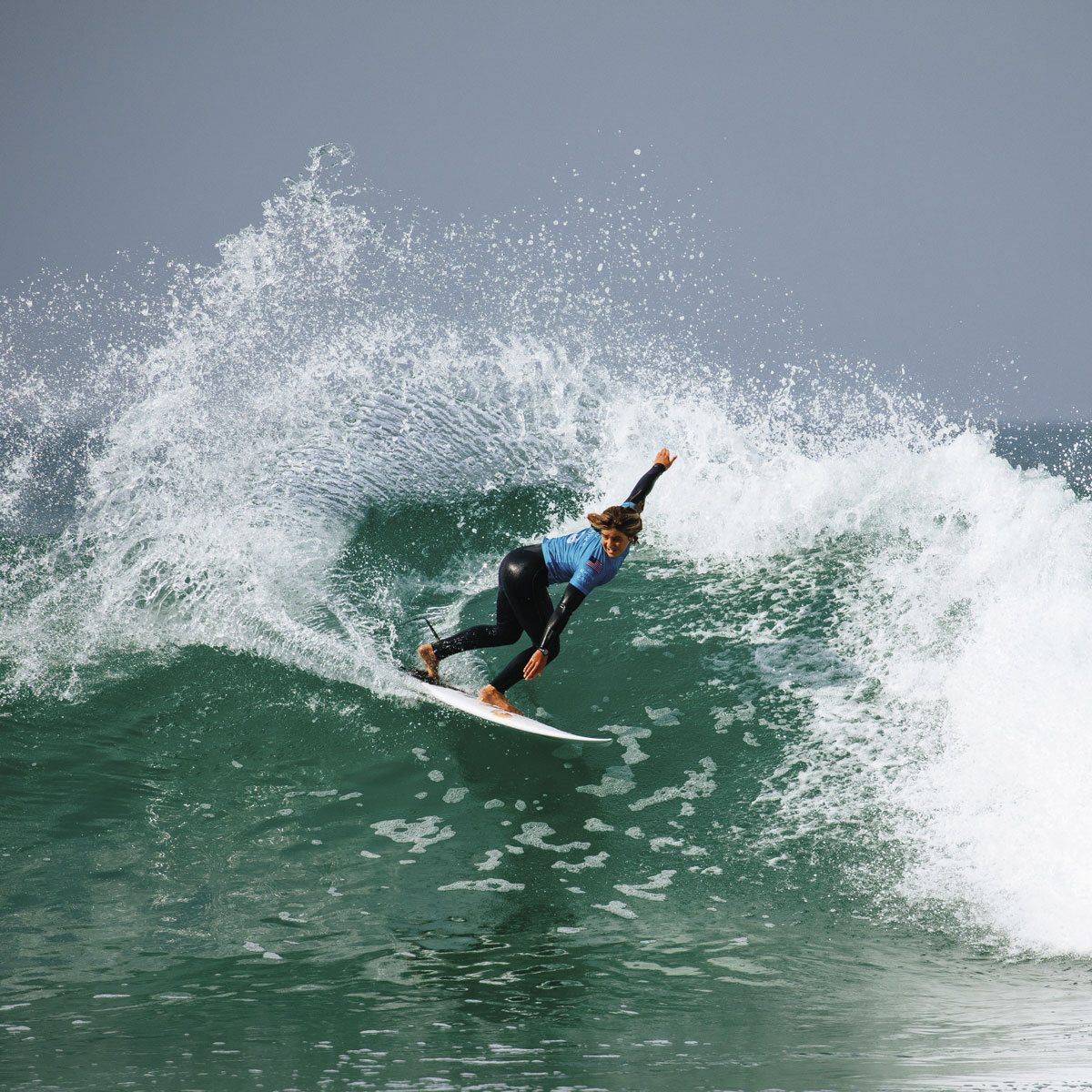
Keely Andrew defeated her in the elimination round. Keely went on to make the semifinals, and Sally Fitzgibbons eventually won the event over Carissa Moore.
Caroline enjoys the coaching input of none other than Mike’ Snips’ Parsons, who doubles up as the World Surf League Big Wave Tour Commissioner. Caroline reckons he is worth his weight in gold. “Mike brings a wealth of knowledge to the party,” said Caroline. “He was on tour for 15 years, so his experience at all the venues is awesome. We also do tons of surf trip and strike missions with Lakey Peterson, who pushes me a lot in the water. As well as running mock heats before events.”
Mike knows very well the long game of the Championship Tour year and is well versed in the venues for the final few events of the year, being Europe and Hawaii, as well as the wave pool event in Lemoore. He will be steering the ship and helping her hold steady.
Even though she is relatively new to the game, and the youngest surfer on tour, there are still hordes of young hopeful girl surfers who want to know how to qualify, and how to get to where Caroline is right now.
“If I were asked to give some young hopeful surfer some general advice, it would be simple,” said Caroline. “I would tell them to have fun with it, give it all you got every time you surf, but don’t put too much pressure on yourself.”
In the Corona Open JBay, she came up against Tatiana Weston-Webb and Silvana Lima, both seasoned competitors. She defeated them both, with her devastating backhand attack and buckets of spray, with surfing that is raw and powerful, yet stylish. When she found her groove, she was unstoppable.
With her nous in small beach break surf, as displayed at Duranbah, she will be a contender in the beach breaks of France and Portugal. Her honed backhand power attack is also going to hold her in good stead when they hit Honolua Bay, one of the best right-handers on the Women’s Tour.
Caroline also has a bubbly, energetic vibe about her, with a relaxed nature when it comes to dealing with media and dealing with the fans and the public. Always ready for a chat or to pose for a selfie or two, she is humble and approachable, while still garnering much respect from the media as well as from fellow surfers. She is a world champion in the making.
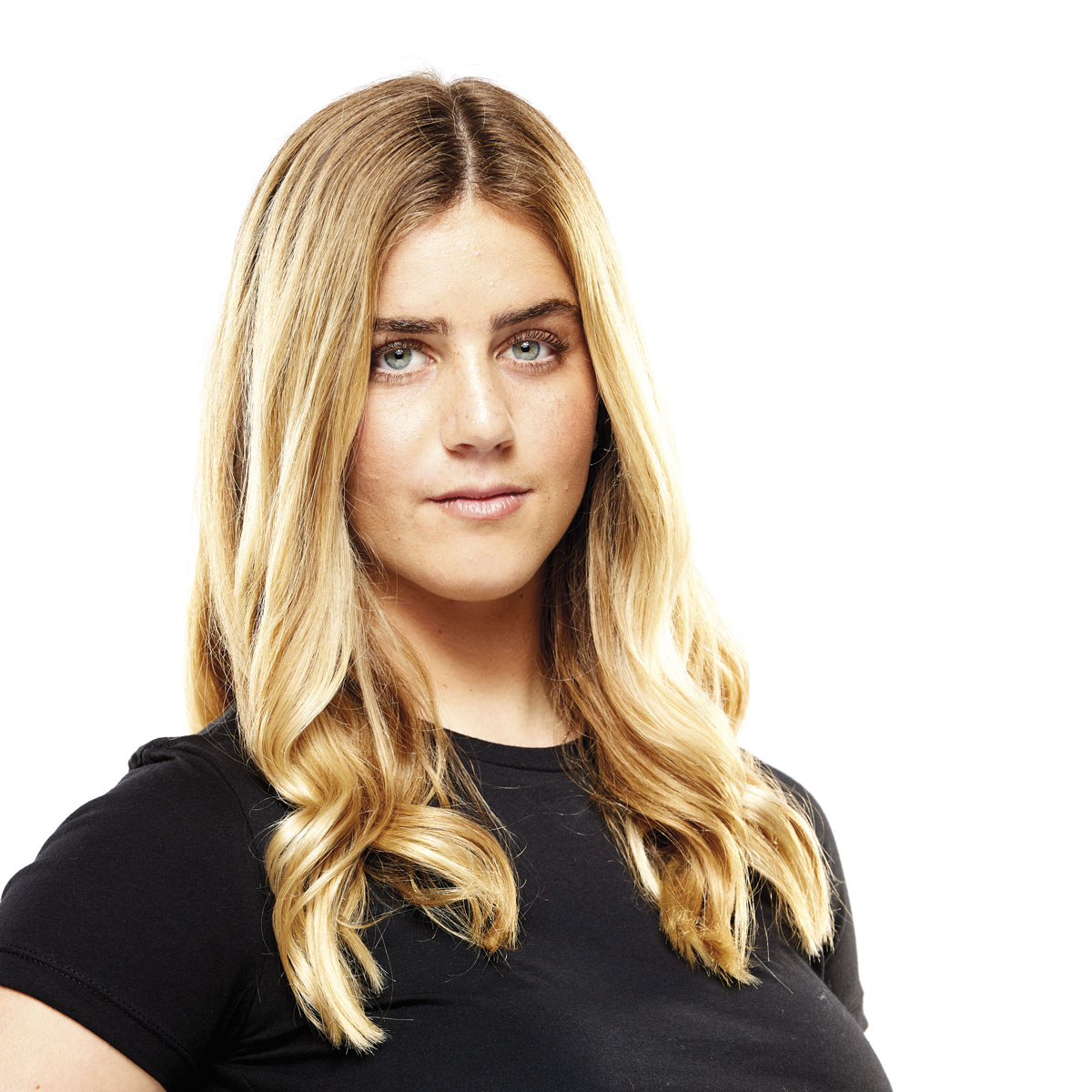
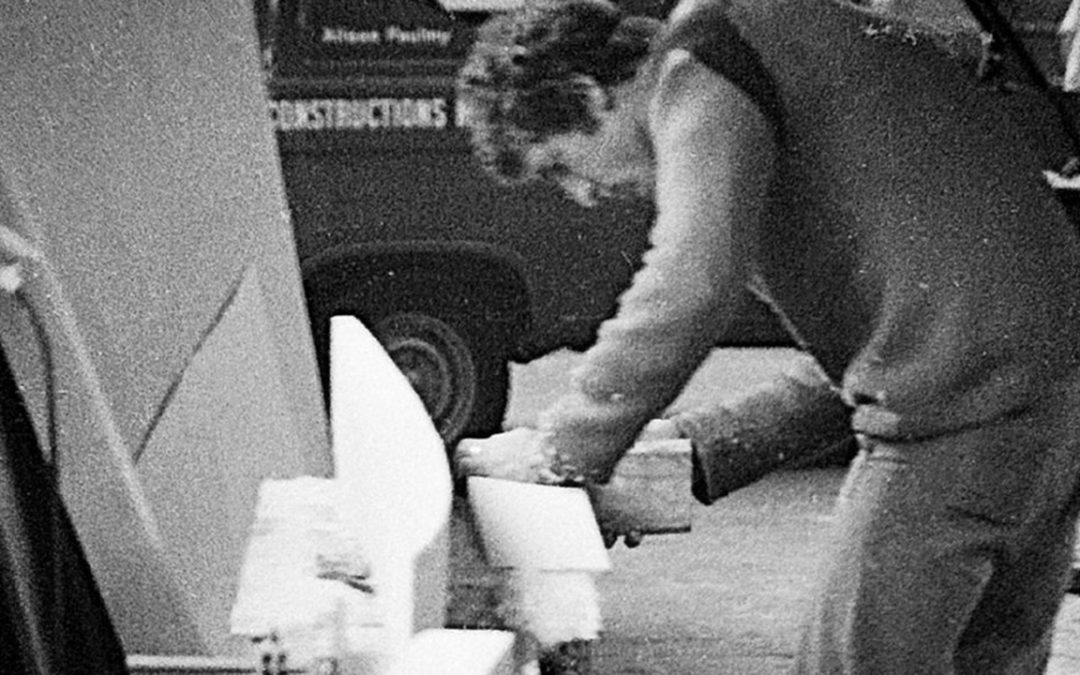

Nat Young is one of the surfing world’s gods, worshipped the world over for his ethereal style and ability to read the waves and know the right board for the conditions. He is the winner of four world surfing titles and an inductee of the Australian Surfing Hall of Fame (1986). In his new book, Church of the Open Sky (published by Penguin Random House), Nat explains how and why surfing becomes cult-like and shares some classic stories about the characters he’s met over the years including Miki Dora, George Greenough, Bob McTavish, Bruce Brown, Kathy Kohner – the real Gidget – and Midget Farrelly. Church of the Open Sky is a beautiful homage to surfing and the way of life embodied by those who surf. Young is respectful and intelligible in his recall of some of the greatest surfers (known and unknown) who are all forever in search of the perfect wave. The book is a testament to his passion and knowledge of surfing and the personalities within it.
What was the motivation for writing this book, Nat?
Well, I’d been thinking about it for quite a while, since I turned 70. Then last year I had a knee replacement operation and I was lying around in bed for several weeks, so that gave me the opportunity.
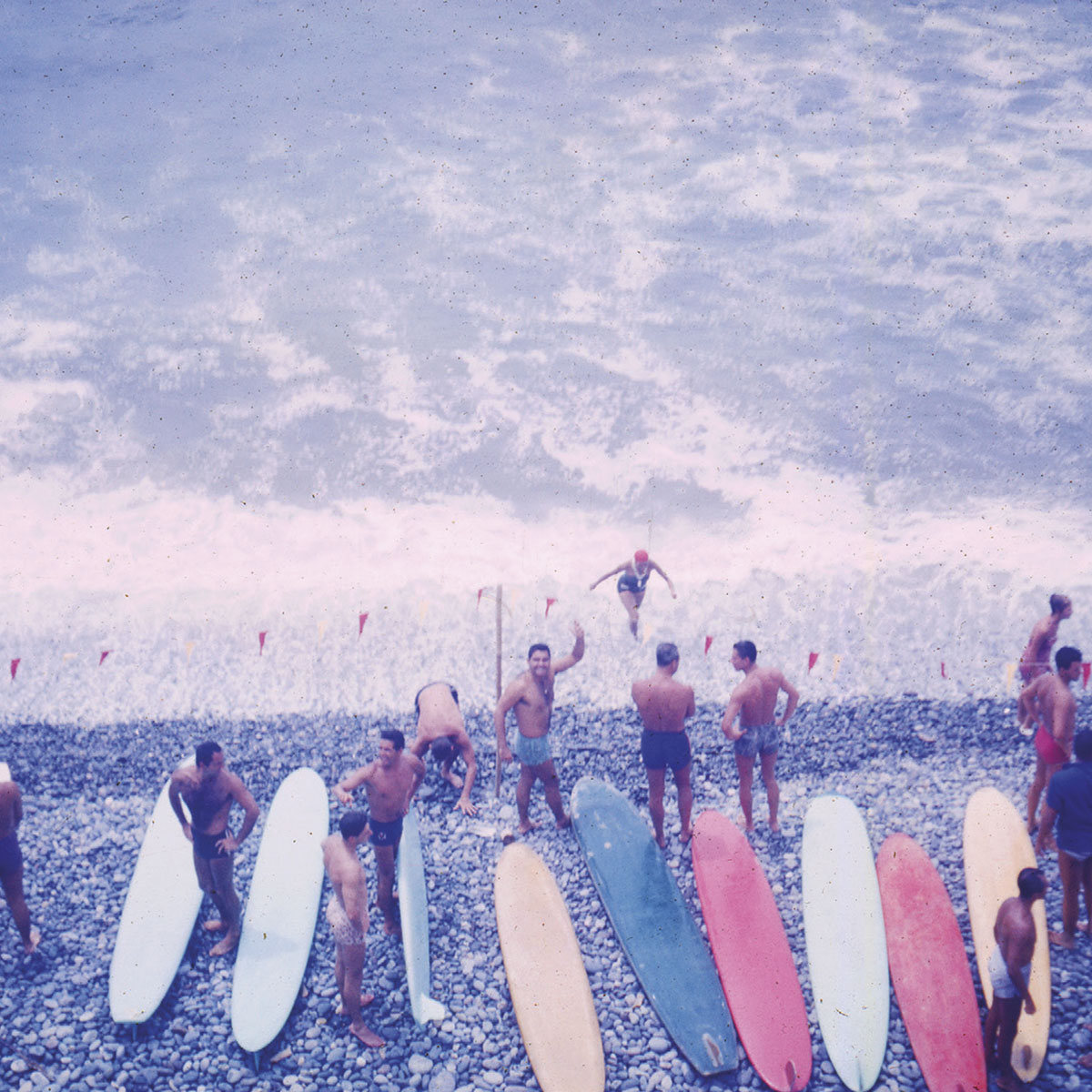
And since then you’ve made a full recovery and you’re back in the water?
Yeah, it took a while, but I got back in the water, started surfing again. And then we had such a good winter on the North Coast [of NSW], probably the best winter I’ve had there, it was fantastic. In three months, there were only a handful of days without good waves, you know, four to six-foot waves. I’ve never known it that consistent. There was a stream of lows coming down from the tropics for months on end. It was so good. I’d been planning to go to Indo, but I never left Australia! I just stayed and surfed every day, two sessions a day.
Two sessions a day – that’s good going for someone in their seventies!
Well, as you get older, that’s what you gotta do. You gotta keep it going as long as you possibly can – not stop the activity at all. You’ve got to keep going. I’ve never stopped, and that’s put me in a pretty fortunate situation.
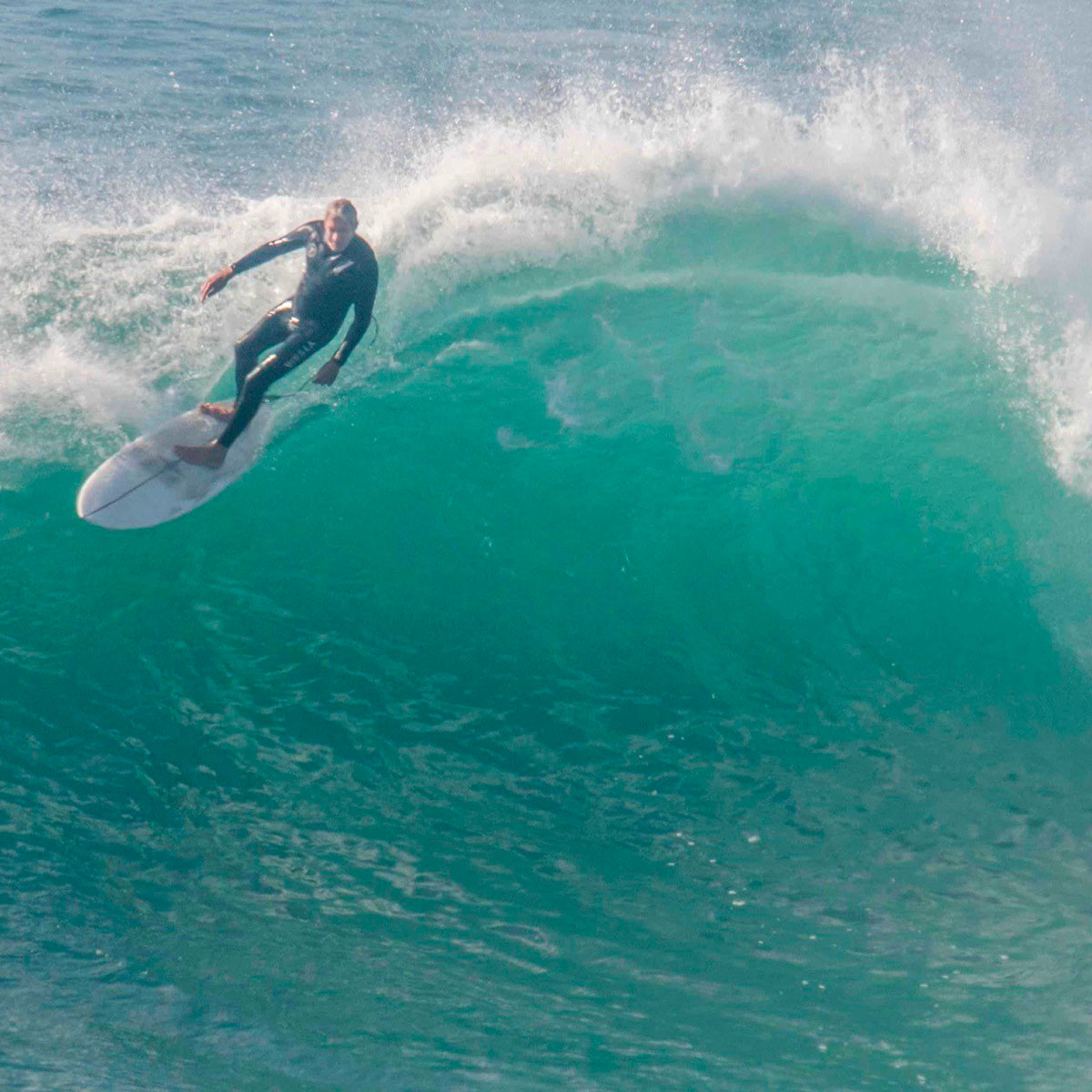
So what boards are you riding at the moment?
I’ve got a quiver of Ryan Burch boards, asymmetric boards. I love ‘em. Most days I’ll ride an 7’3” asymmetric, with plenty of thickness, like 2-3/4” thick.
Tell us a bit about the book. The first chapter is called ‘Surfing Is Not a Sport’ and that seems to be an underlying theme…
Yeah, well, originally that was going to be the title of the book. ‘Cos that’s how it developed for me, around the time of Morning of the Earth and all that. I really had very little competitive instinct at that point in my life. Maybe I was getting a little too stoned or I’d lost the competitive urge, I don’t know! But I think that’s when I was doing the most progressive and the best surfing of my life. I was surfing Lennox Head a lot, and riding those classic pintails that I was building on the farm at Byron Bay.
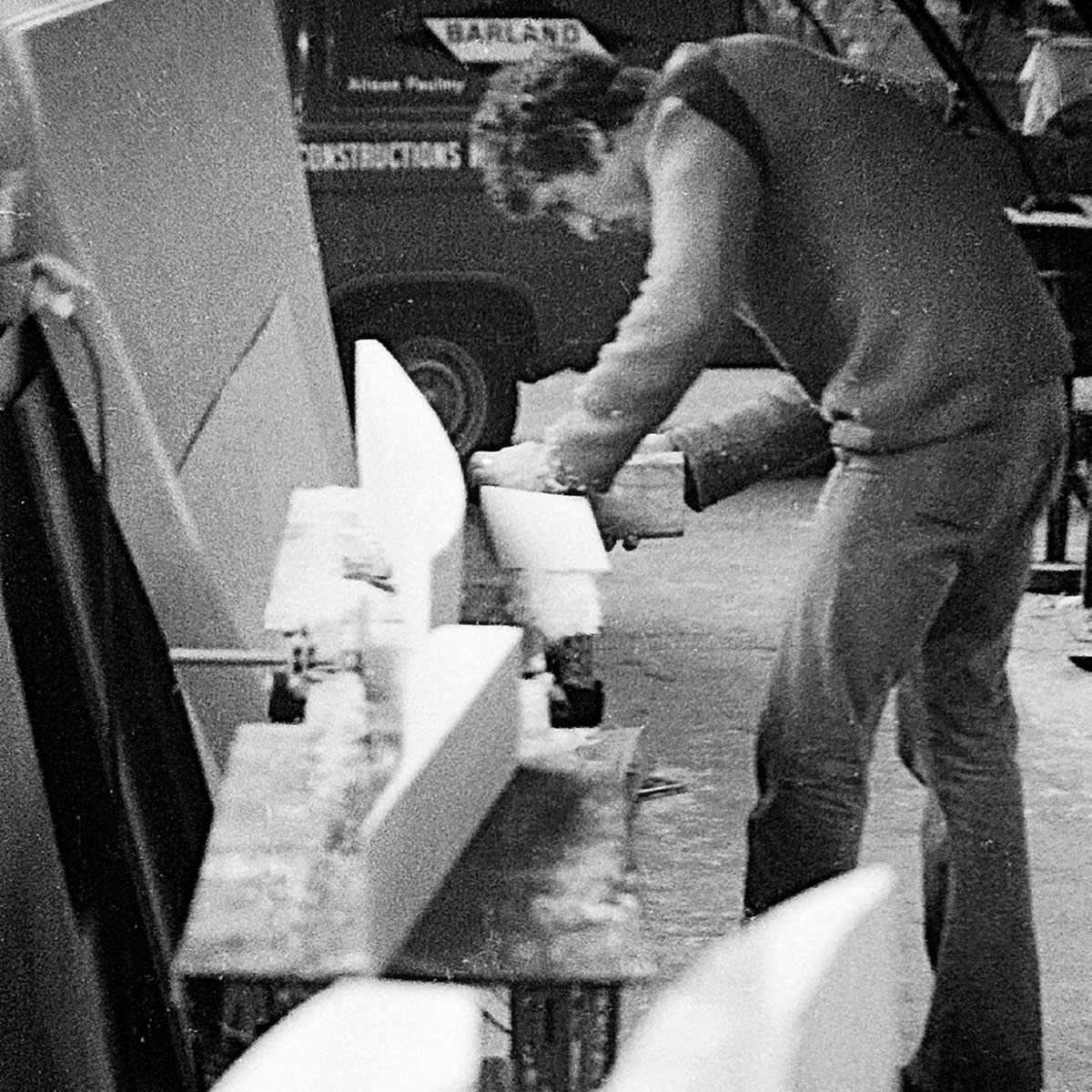
So are you still interested in competitive surfing? Do you still follow what’s happening on the pro tour, or are you over it?
Well, it’s not that I’m over it, it’s just that I find it boring! I don’t think there’s enough emphasis on style, I think it’s all about manoeuvres. And it’s gonna get worse if they do more contests in wavepools, ‘cos then everyone’s gonna be riding the same waves, on the same equipment. I mean, I can understand how some people find it entertaining, people who are really into it. But for me, no, I find it boring. I’d rather go surfing myself, personally.
There’s a chapter in the book about a trip to Morocco that you did in 2018. What did you think of the place?
Well, the first time I went to Morocco was in the late ‘60s, and I hadn’t been back there until last year, when I spent a few weeks there with my wife, my son Bryce, and a few other guys. We had a great time, I really loved it. There were so many European surfers down there, it’s obviously become a very popular place. And I can understand that…I mean, the quality of the surf is incredible. And the vibe is really good too. The only time it wasn’t so good was at Safi – as I mention in the book – when some of the guys in the water got pretty aggressive. I don’t know if they were local guys, or guys from France and Spain. I didn’t want a confrontation so I just surfed further down the bay. But I tell you what, the quality of that wave is amazing!
There are some good stories in the book about people you’ve met over the years, guys like MIki Dora…
Yeah, I’ve written quite a few books and articles over the years but there are still a lot of stories to be told. I’d never told the Miki Dora stories before. He was such a character! He was probably the most bizarre surfing character in the world, really. And yet, he was one of our tribe. So, yeah, from my point of view, it was a delight to be able to tell those stories.
You’re doing a sort of a Southern Hemisphere tour, promoting the book around Australia and in California. It seems like it’s been well received.
Well, one of the biggest compliments I’ve had was from Nick Carroll. He called me and said, “I’ve gotta tell you, Nat, it’s the best thing you’ve ever written.” And that’s pretty good to hear, ‘cos he’s a terrific writer. So, yeah, I feel good about the book, I’m pretty proud of it.
Church of the Open Sky is published by Penguin Random House.
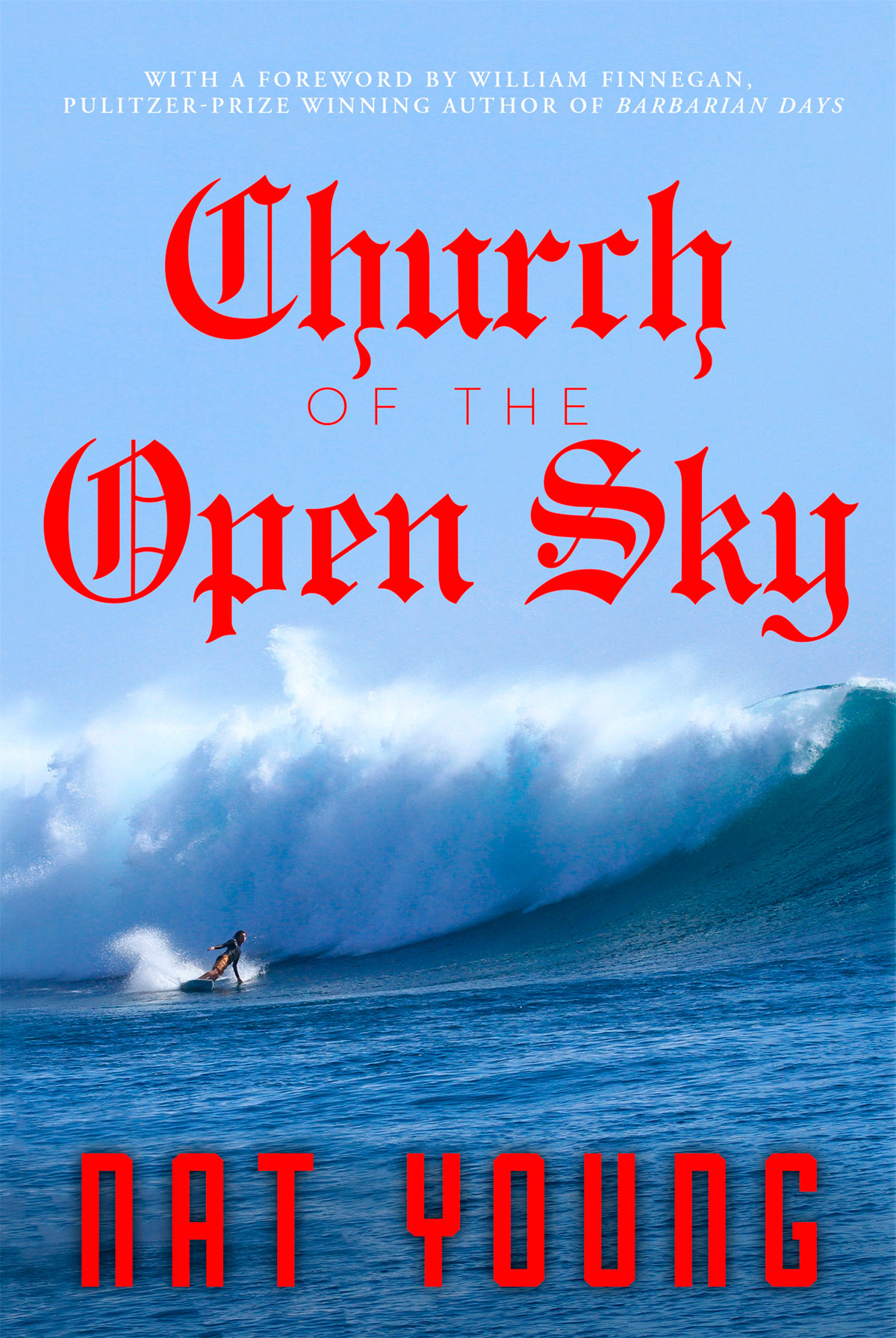
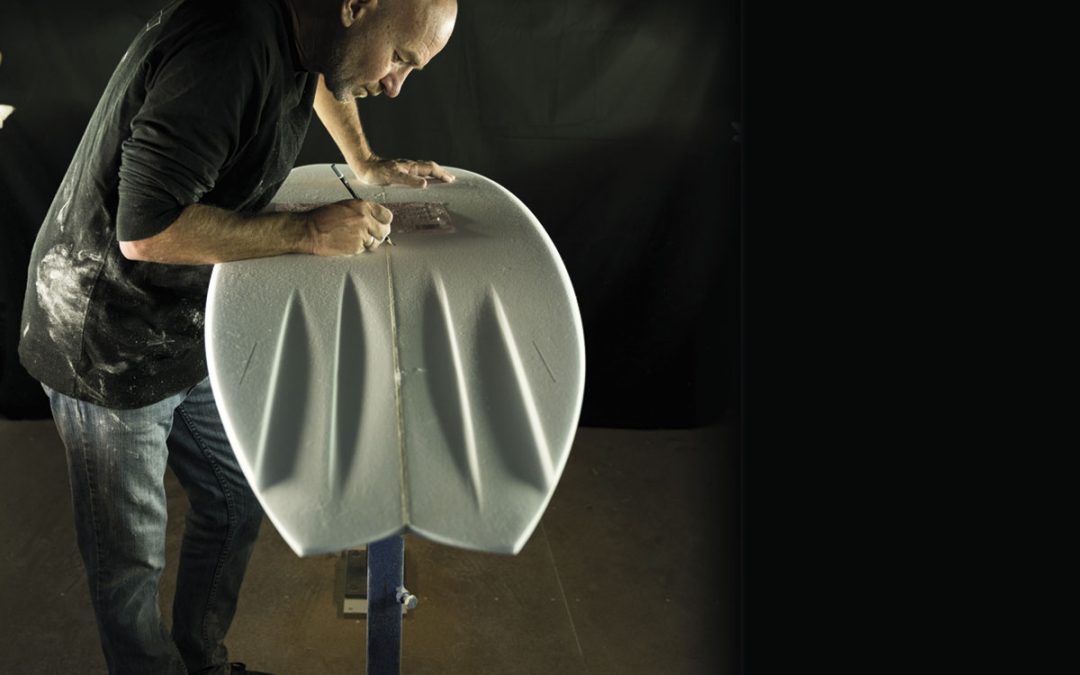
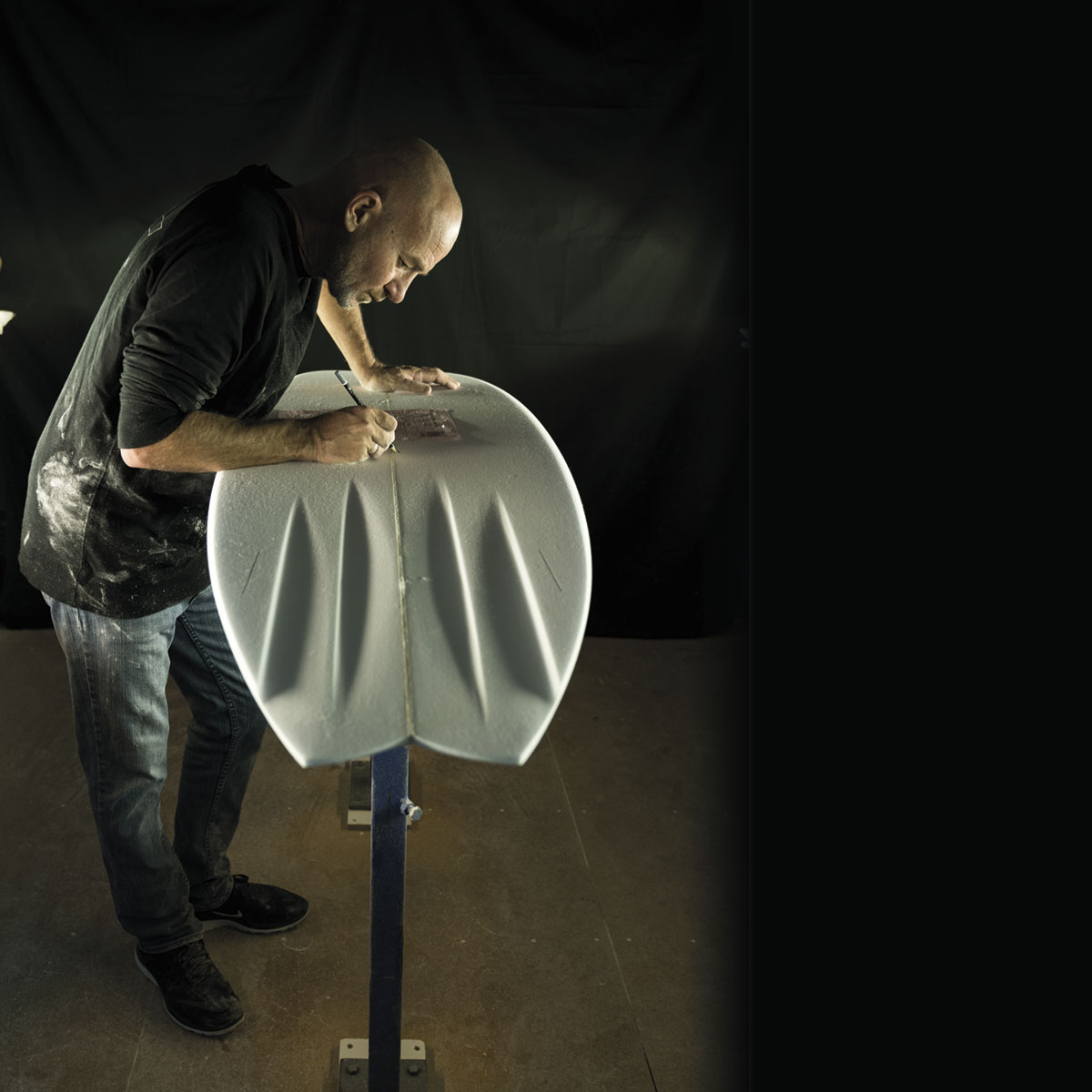
The foam wizard that crafts the sleds that took Mick fanning and Steph Gilmore to multiple world titles knows a thing or two about boards
Interview by Steve England Photos courtesy of DHD
Darren Handley of DHD is one of the world’s most famous shapers. But there is a bit more to him than that. Bred at Kirra, he was pushed into his first waves at 12, then became a local stand out and Pipedream team rider. He started sweeping the floors of Murray Bourton’s surfboard factory, learned the trade and set out on his own. Today Darren Handley is at the forefront of cutting edge surfboard design but also loves his surfing. Helping coach groms, and guides some of the world’s best surfers with their lives, and has a keen interest in the development of surfing. In September he came over and gave an excellent board clinic at Down the Line surf shop, Hayle. Steve England caught up with him for a chat.
So pre-shaping you are on the Pipedreams team. Tell me about your first trip to Lakey Peak?
I can’t remember the year, but it was in the early ’80s. I was there with Murray Bouton and the team. His friend had a boat and had found a break in Sumbawa, so he said we are going to this place he had heard of called Periscopes. So we went overland through all the villages and into Periscopes. We were there for three days, and then we went looking for other waves, and we found this left-hander. We were going to call it ‘Double blows’ because every wave blew out twice, but then we found someone who could speak English, and he told us it was called Lakey Bay, so we named it Lakey Peak. We surfed it for like ten days then took off looking for other spots. We went back two years later, and it was a completely different place with buildings and people all over the place.
So Periscopes was found before Lakeys?
Yeah, Periscopes was found by a friend of Murray’s who had a boat. He found it and parked his boat up for a while. The reason it got called Periscopes was because one of the guys from boat dropped one in the water, and it kept on chasing him like a submarine and popping back up like a Periscope! So that’s how the name came about!
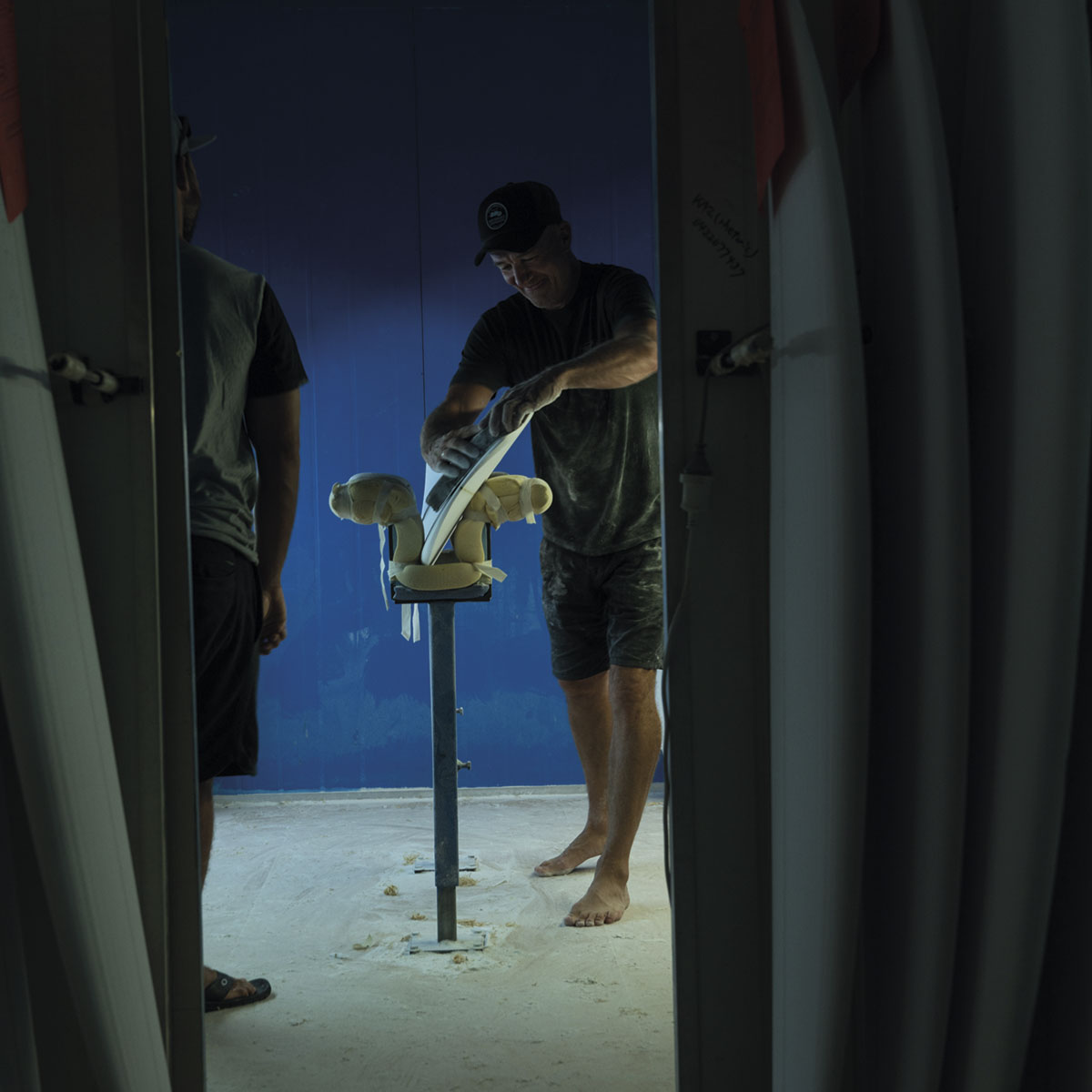
So you were on the Headworx team back then?
Yes, there was me, Murray, Glen Rawling, Alby Ross, Hodge it was a great trip. We slept on board bags with our surfboards around us because of all the pigs running around, and we all got malaria. It was a great trip!
When was the last time you were in Cornwall?
I used to come when the comp was on way back. Things will get quiet in the Australian surfboard market in winter, so I used to go to Europe a lot and work with Maurice Cole and then Pukas. I’d come here because it was easier to speak English than it was to speak French laughs. It would have been 20-25 years ago. I had the best time. I’d leave Aus and spend six months going from Indo to Europe, then back to Indo and back to work for Murray. It was just a great place to come. I never really got to surf good waves, but most of the time I came was in summer or at the end of summer, and I never really scored.
So where are you at with surfboard designs at the moment, because a lot is going on, and so many models. How is it all working?
I have a bank of models sat on my computer that I don’t even pull out. I sit there and play around with designs, shape boards for myself, and experiment. But the market can only handle so many surfboards designs and different things. So it kind of works like this for me. Mick Fanning is good at understanding surfboards, and we have been working together for like 20-30 years since he’s been 13, so we play around with a lot of different stuff, and he rides other boards and sends me emails of things he wants to try. So we will play around with that stuff and if something comes out of the blue, and he says, ‘This thing is incredible’, and he starts riding it more and more then more and people seeing him ripping on it. If he loves it, then we refine it and decide to make it a model. We are about to do that this summer (winter UK) with another Mick Fanning model. We haven’t had a new MF model for quite some time as the DNA was such a great board, and he was so far ahead. But now we have a new one, and it will be out in the early summer 2020 in Europe. But that’s what we do. We tinker around with stuff. If Mick tries it and says it is going to be good, then he’s going to push it and it becomes a model. So we try and keep things fresh and strong, but not just push things out just because someone wants a new board.
And from a consumer point of view what is your best advice to someone wanting a new board because there are so many models and so many different fins it is tough to choose the right set up these days?
The best advice? Well, you’ll sometimes hear stuff word of mouth about a board, but I’d say if someone pays a lot of money for a board, they are not going to tell their mate it goes crap! So sometimes you can’t take your mate’s advice, but if you do see them ripping on it then maybe it’s the board you want to try. And try your mates’ boards. It’s an easy way to find out precisely what you like. Read up online, but don’t believe everything you read. People say stuff just because they want to sell more and more boards, which isn’t good for anyone. I think that is the reason some brands are so strong because we don’t just piss in people’s pockets just for sales. We believe in our product, and all the things we do are real.
Second; fins are really important. Don’t just ride a board with one set of fins. Try other sets. Don’t just ride a board and think it is no good when you have only tried one set of fins. You have to try two or three sets. Fins can change the way boards go so much, especially in different types of waves.
Also, check out second-hand boards, check out who is ripping on your local beach, and what they are riding. And don’t just by a board because it is cheap. Usually cheap doesn’t mean it is good; it just means it is cheap.
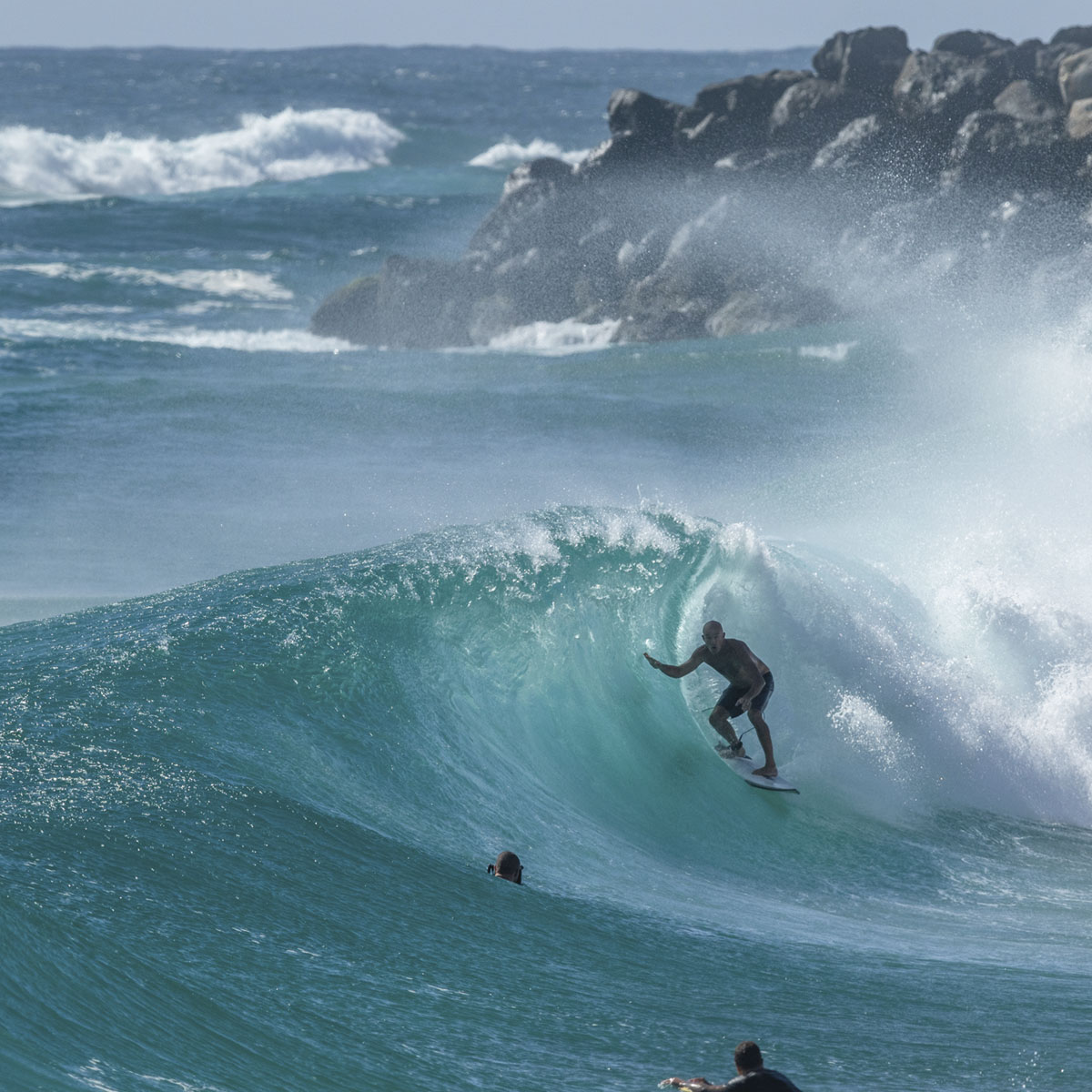
Do you think surfers need to speak to shapers and qualified shop sales folk more in the flesh?
Shapers like myself are hard to get to sometimes. I love going to stores and answering the questions and giving advice, but people can also send us questions online asking for help. And every good hardware surf shop that stocks a lot of boards, a lot of fins, a lot of grips, know their stuff, so the advice that is coming out of qualified salespeople from one of those shops is like it is coming direct from the shaper. They know all the shapes, they have real-time feedback from other customers, and they aren’t just going to sell you something because they want to sell you something. They want you to come back, or tell your mates how good your board is and how helpful the shop was. So don’t be scared to ask, even if you are not a very good surfer, be honest and get some good advice.
Volume?
Laughs.
Good or bad?
Volume is great in the fact that it gives a shaper something to work on when you do a custom order, which is only 5-8% of the business in Australia. Volume isn’t everything though. It helps, but always remember length is your enemy, especially if you want to chuck it around. And width and thickness are your friends. So the shorter you can go with the width and thickness the better, especially if you are not a great surfer. But volume is just one of the tools and a guide. I hate when a person goes, “I want this board, and it has to be 28.41.” I mean that .41 is a handful of dust that fell on the floor, so it is just a guide.
When it comes to surfing paddle power is the most important factor, and most people equate that to volume. But what do you think is the most crucial factor in paddle power? So it’s more about a combination of factors. I will use the Black Diamond as an example. All the volume is upfront, and it is quite wide-nosed, so you think that the board is going to paddle well. And it does paddle well, but it doesn’t paddle into some waves as well as an under volume board that sinks and pearls. So I can paddle out back well on it, but once the wave picks up the board with less volume it penetrates the lip and gets you into the wave face quicker and easier when it is suckier. So the less volume you have, the easier it is to get into waves. But some people can’t ride those under volume boards, so you have just got to make sure you don’t over volume your board and think you will get you into waves better. Because that doesn’t happen, you see some guys on longboards with lots of volume paddle out fast, but then they get stuck up on top of waves and don’t get let in. That is what happens when you have too much volume up front or under your chest.
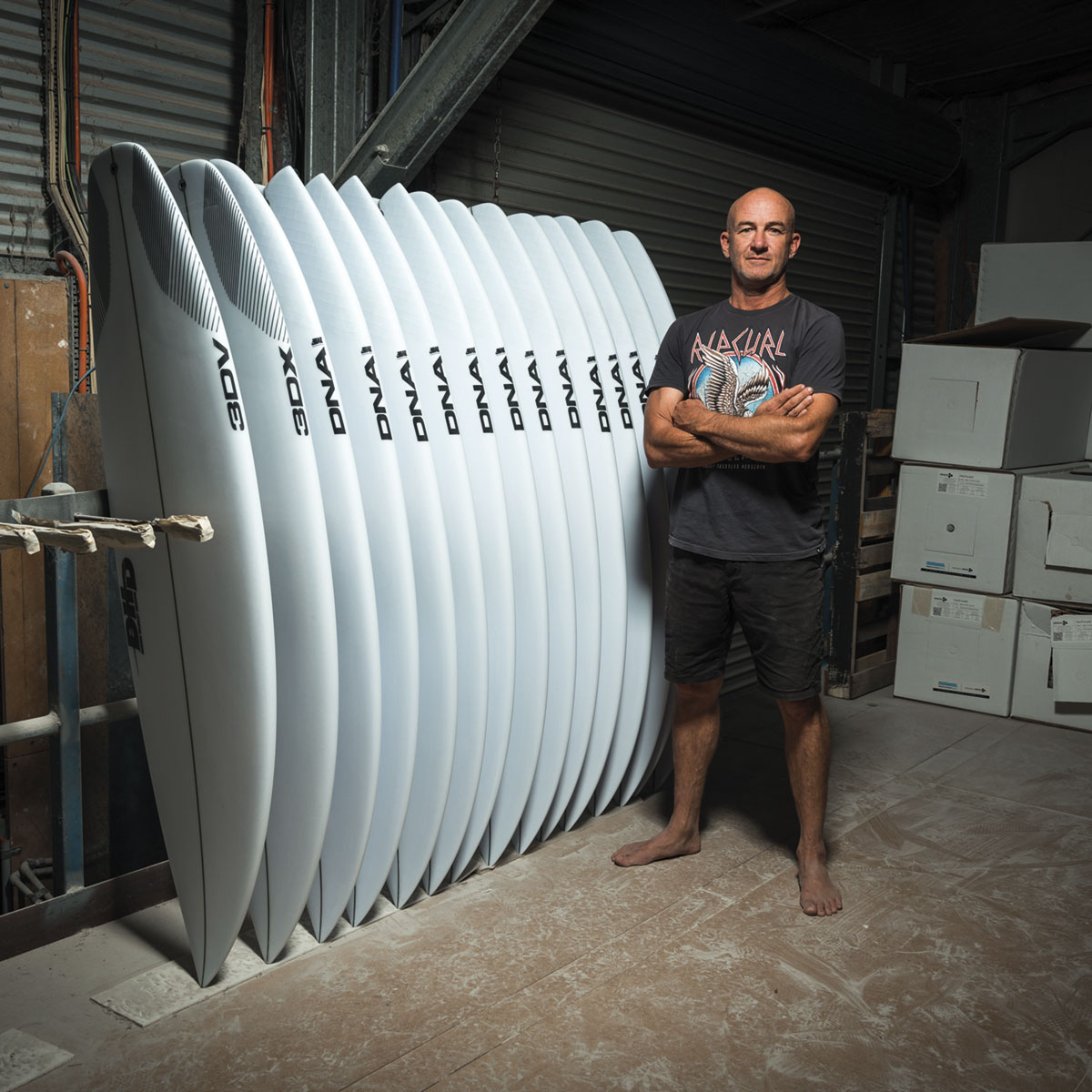
So R+D and wave pools, the ocean versus wave pools, what are your thoughts?
I was lucky enough to go to Kelly’s wave pool last year for a week with the Australian Olympic team. I had about 30 waves given to me and another 30 I stole when someone fell off, and it was about $170,000 worth of waves!
Yeah! I think we worked it out as costing about $409 per wave! That’s what we worked it out as. It may be cheaper than that now, but it was about $50,000 a day, and there are 125 waves a day.
But I loved it! The first right got I couldn’t believe it. How much it was like Kirra and the left was OK, but we don’t go left that much, so I stuck to the right, but the left was still great.
That is where I came up with Owen’s board which he did so well on at the pool in the comp. I was with him, and we had the Wilko model, which was a wave pool shape kind of of a board, so we worked on a specific shape.
It excites me that there are going to be many wave pools built and they are going to get better and better. This is how I see them, using golf as an example. It costs a lot to be a golf member at a great club, but if you work hard and have the money to buy a membership, then you can take your friends up there for a discount, or book your tee times to suit your day. So if there is a wave pool nearby, I can get up early before work and go up there. I’ll have my waves booked in at 7.15, 7.32 and 7.45, and I’ve only booked right-handers. So by the time I go to to work I’ve had my three waves, had a shower, got changed, had a coffee and laughed at me mate who fell off on one of his waves. We’ve chatted about who had the best waves, and off I go to work with a smile on my face.
The alternative for me is that I paddle out at Snapper if it is pumping. I paddle out miss my first wave get run over by the 3,000 other people who are out there trying to get a wave before work. Go to work with the shits, sack the first person through the door, and go “Fuck this!” So that’s why I think wave pools, for me at my age, are amazing! I am not going to sit out there and fight for my waves any more. I am just going to work harder and pay for my waves.
From a shaping and performance point of view, do they excite you? Because you have the repetition.
Yes. The thing about the wave pool is that it opens up more performance. I was riding 32-litre boards when I went to the pool because that is what I use to paddle out at Snapper, fight the rip, and out paddle Parko on the point. But I got to the pool and the board went well, but I also rode Owen’s board and then I rode Wilko’s board, and I went back down to 28-litres. It was amazing because I didn’t need the paddle power any more. I could ride boards that I could surf. I think you can lose a lot of volume in your boards and get performance. In saying that, after watching the comp and seeing how well Gabe surfed I think he has mastered something in his surfboards where the volume doesn’t give him any downtime. He sits on his board, and he controls the surfboard rather than the board dictating what he can do. It was fascinating to watch. I work with a few coaches, and when I go down to France, I’ll have a chat with Jake Patterson, and work out what is going on because they are all interested in what Gabriel is riding and how he is surfing.
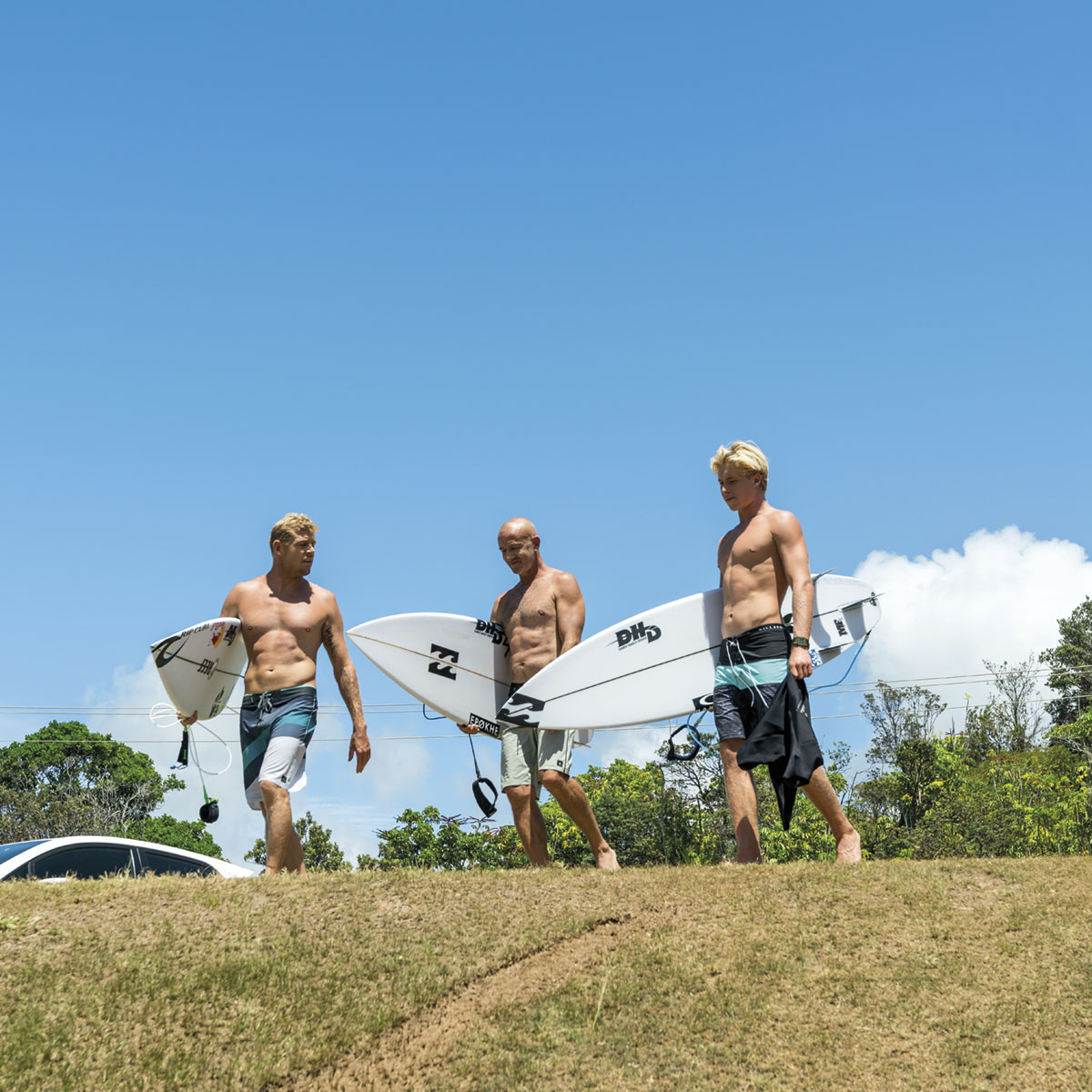
Do you think he is the most switched on pro at the moment?
I know Gabriel quite well, I’ve hung out quite a bit, and he is a great human, funny as, but when the game is on, he is like Mick, and he turns on. Mick is the perfect example of someone who didn’t have the natural ability of some, but he worked hard on his talent, his fitness and worked hard on his equipment. He had a checklist that he worked to – fitness, surfboards, coaching, and he worked on improving his weaknesses until there were none. And I think Gabe has taken a bit of that from Mick. I think Gabriel is the perfect athlete, and then you’ve got to understand with his surfboards, Johnny shaped for everyone. He’s shaped for me, Al (Merrick), Mayhem, so he has shaped for all of us, and then he went and did his brand, so he has a lot of experience, he learned from the best and Gabe has kept him for himself, so it is a smart move from Gabriel.
The Olympics, is it the golden goose, will it take surfing through the roof?
I was pretty excited for the Olympics to be in a wave pool, but then I watched the wave pool last week, and it was great watching my guys surfing but otherwise it was fricking boring. And I think if the waves are small in Japan, it’s going to be boring again. I mean they just had the ISA worlds, and it was pretty exciting, the girls were good, but I think they can do better. In Australia we have a tag team event, five team members go and surf off, they run-in, run-out, and it gets pretty exciting to watch with people under pressure running up and down the beach, scores changing and he team element. So I think if they did the individual event and then decide the team placing in a tag team and you get to see Kelly run in, and you have that excitement and make the team a bit bigger, that would make it more exciting. To me, the team event would be the exciting part I am a bit worried that people are going watch it and go ‘This is fricking boring’, but if it is big and good and quick, it could work. You could see some unknown paddle out and win the Olympics because it was 20 minutes best four waves, and the CT are used to waiting. I don’t know Bobby Martinez doesn’t like it and he is usually right!
What do you make of the CT at present, I think I am missing the characters?
With Mick, Parko, Kelly all finishing up it is not as exciting as it used to be. Gabriel is surfing well, and there is the Brazilian storm, so I am sure all the Brazilians love watching. I love to go to the beach and watch the surfing, but I don’t think they make it very good for the spectators. The pros are all down there sitting in nice stands, but the spectators struggle to park, they don’t know where they can sit, usually, they can’t see too well. They should be able to take the family and the kids just like going to the football. They should get their car passes, food, and sit there in the stands having a great day out. It should be the other way round I think with the surfers at the back and the spectators at the front in a grandstand. As far as the waves or good or bad, it doesn’t help with inconsistency, but it is what it is. I think they are going the right way. Chopes was good, Snapper was really good, Bells was really good, and they are changing the QS, so they are trying to do the right thing, but without the Kellys, Parkos and Micks, it could lose its flavour.
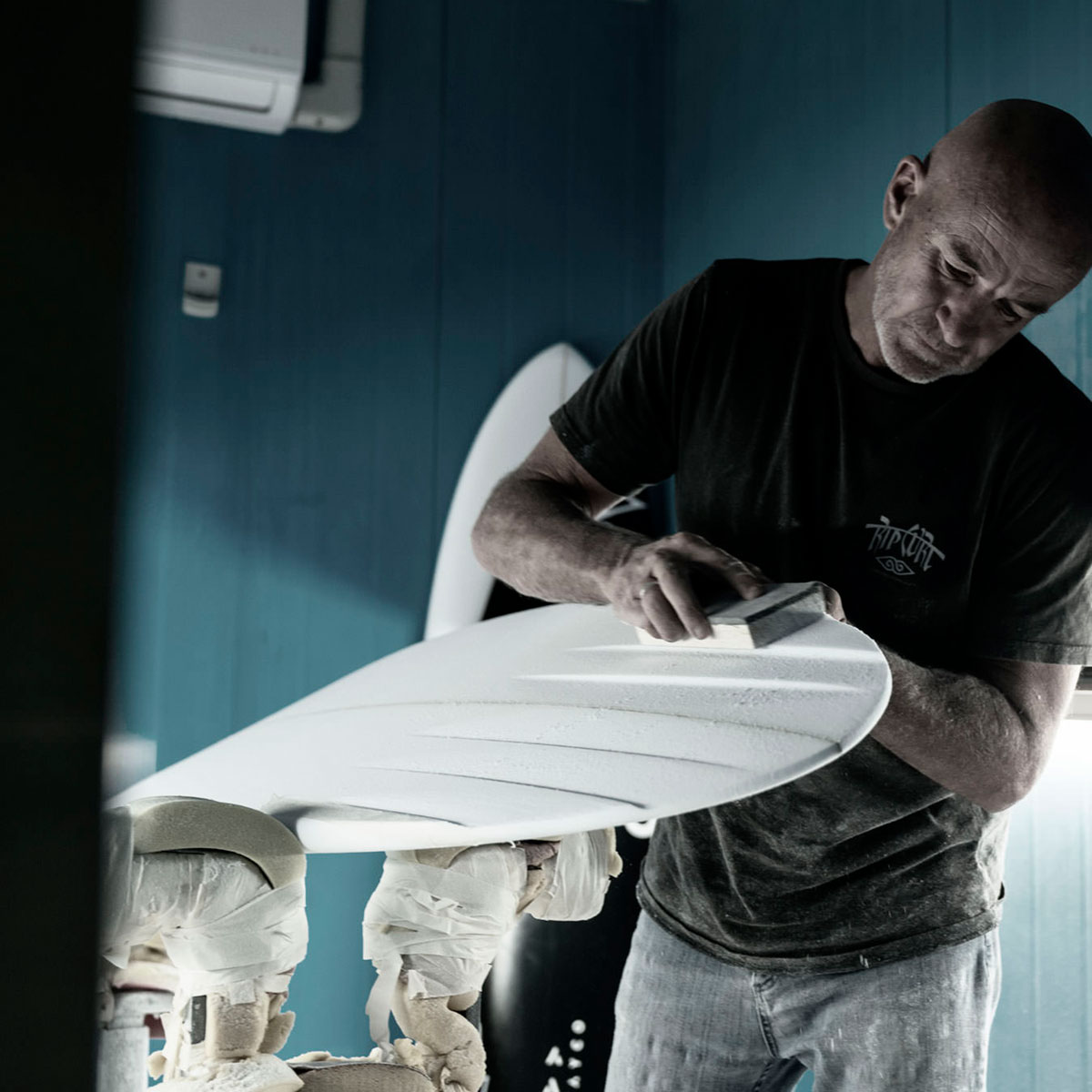
Any grom boards tips?
It’s a hard one with the grom boards. I do have a few golden rules because all the parents think that if Mick and Steph are riding my boards, then their kid is going to be the next Mick and Steph if they ride one. So I go to junior comps, and I don’t even get to watch the kids because the parents are lining up asking me advice on the kid’s boards, but I have some rules.
First one is that their board should be as tall as their hairline if you stand it up. If it is halfway between their hairline and eyebrows, it is on the verge of getting too small, unless it is a little wave groveller.
It has to be hairline or inch longer. Then the width and thickness depending on their body. But at least they can get the rail length right with that easy test, and that is important. There is this thing where a grom can ride a board for too long, and it ends up too short, and then when they get their next board which is the right size and they can’t turn that one because it is too long. But if parents are serious, they need to invest in two, three or four boards per year for a grom to develop. And get the kids to ride other kids’ boards down the beach, but if you don’t invest, you will never know how good your kid could be.
Can you remember your first green wave?
I can! I was surfing Greenmount at 12 with my dad. He had taken me out on his board, and I stood up on the first three whitewashes and was a goofy-footer! And dad, who is a goofy-footer, goes “You’re going to be the living in Queensland mate, you need to turn the other way!” I didn’t know what he meant, but I got up and turned around the other way. On the fifth wave, he pushed me into a green wave, and I got up and went along it. And I still remember it to this day. I turned out to be an OK surfer, so I think about all the good waves I’ve had on the Goldy as a natural foot … but when I am drinking beer with my dad, I always say, “You know what, dad, I did OK as natural footer, but I could have been a world champion goofy-footer!”
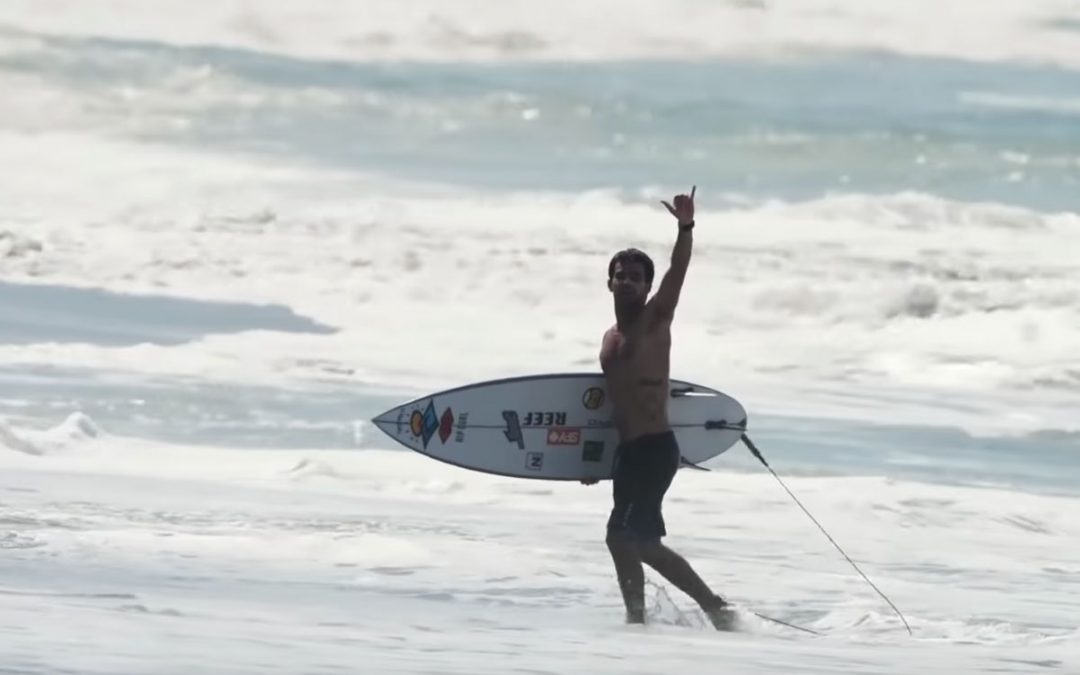
Mason Ho puts the fun back into surfing, last year he dropped relentless styling clips of his numerous surfing escapades online. Enjoy a 30-minute montage of Ho and crew at their very best, we can’t wait to see what’s gonna drop in 2020.
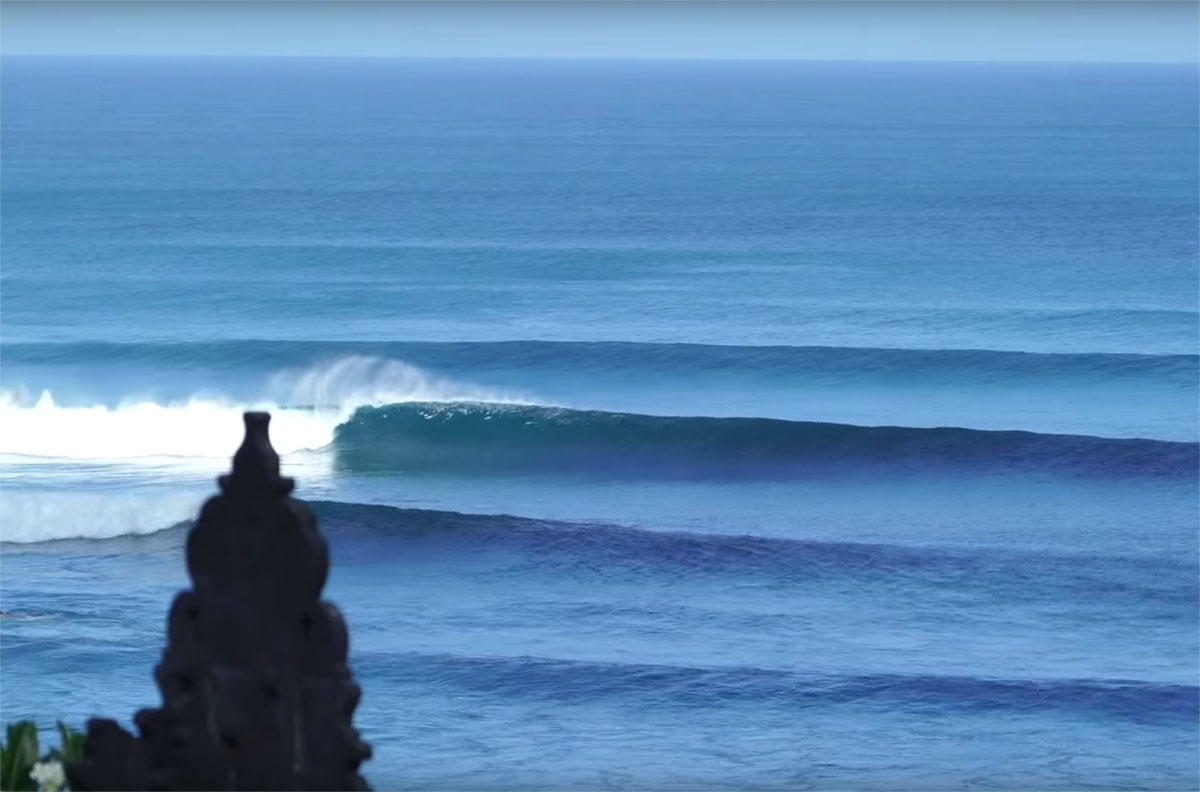
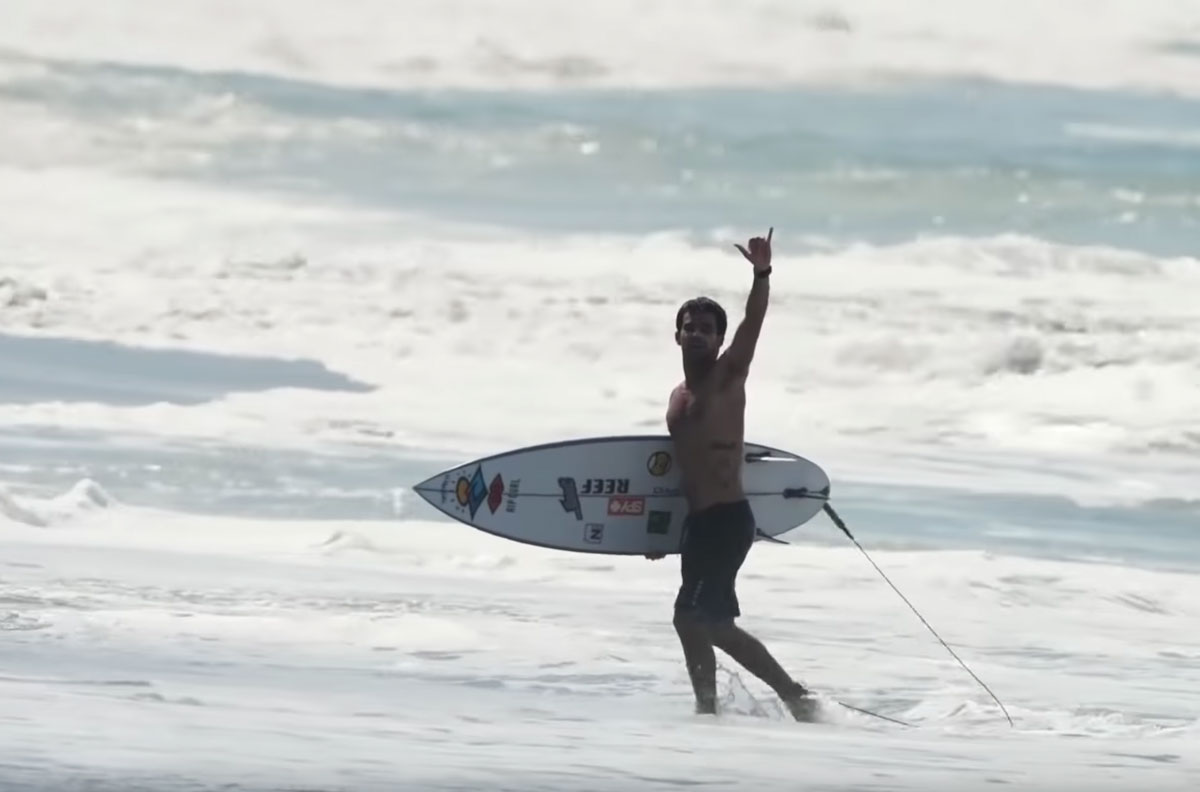
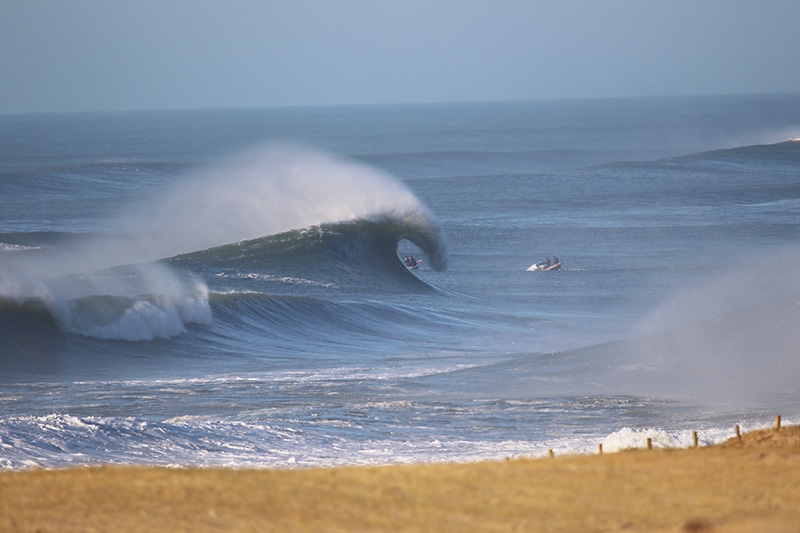
Miky Picon, Joan Duru, Marc Lacomare, Laurent Pujol, Vittorio Vallauri take on huge Grav on Christmas day